Atlanta inclinata
Atlanta inclinata
Roger R. SeapyIntroduction
Atlanta inclinata attains a large maximal size (to 6-7 mm), and the adult shell is clear to light yellow. The keel is moderately elevated, with a rounded to slightly truncated leading edge. The spire consists of about 5 whorls and is globose (or beehive shaped). The internal walls of the spire are decalcified. The spire surface bears small, low tubercles (or punctae) that are usually scattered but sometimes can form irregular spiral lines. The inner surface of the spire has radially-arranged lines (as in A. tokiokai). The innermost whorl adjacent to the umbilicus is rounded and has a low and wide, but nearly indistinct, ridge. Eyes type b, operculum type c, and radula type II. The radula is large, with a growth angle of about 16°, and the number of tooth rows are limited to about 60. The lateral teeth are monocuspid, and the rachidian teeth are about 20% wider than in A. tokoikai. The species has a cosmopolitan distribution in tropical to subtropical waters.Diagnosis
- Shell diameter to 6-7 mm
- Adult shell clear to light yellow
- Keel moderately elevated with a rounded to slightly truncate leading edge
- Spire tilted relative to shell plane and consists of about 5 whorls
- Spire shape globose or beehive shaped
- Internal spire walls decalcified
- Outer surface of spire whorls with small, low punctae that are scattered or form irregular spiral lines
- Inner surface of spire with radially-arranged lines
- Innermost whorl adjacent to umbilicus rounded, with wide and low ridge
- Eyes type b
- Operculum type c
- Radula type II
- Radula large, with a growth angle of about 16°
- Number of tooth rows in radula limited to about 60
- Lateral teeth monocuspid
- Rachidian teeth about 20% wider than in A. tokiokai
Characteristics
- Shell
- Maximal shell diameter large (to 6-7 mm)
- Shell clear to light yellow in color
- Spire inclined relative to the shell plane
- Spire consists of about 5 whorls (see SEM below of juvenile shell)
- Spire shape globose (beehive shaped), with shallow but distinct sutures evident when spire is viewed from the side (see larval shell below)
- Spire surface with small, low tubercles (or punctae) that are usually scattered, but can form irregular spiral lines. Tubercles occasionally continue on to first teleoconch whorl
- Inner walls of spire with radially-arranged lines, which can only be seen using transmitted light (click on image below to resolve the radial lines, which are seen most clearly in the upper portion of the outermost whorl)
- Internal walls of spire whorls decalcified (see transmitted light photograph below)
- A very low, wide spiral ridge is present on the rounded whorl adjacent to the umbilicus (see second SEM below)
 Click on an image to view larger version & data in a new window
Click on an image to view larger version & data in a new window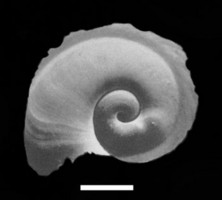
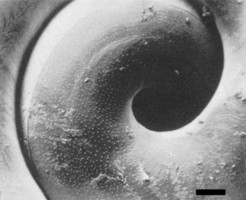
Figure. Shell of Atlanta inclinata, viewed from the left side (left) and enlarged to show umbilical region (right). Images from Richter (1990, figs. 4 and 16), modified by addition of scale bars (= 1.0 mm and 100µm, respectively). © 1990 G. Richter
- Eyes type b
- Operculum type c
- Radula type II
- Radula large, with a growth angle of about 16°
- Number of tooth rows limited to about 60
- Lateral teeth monocuspid (see SEM below)
 Click on an image to view larger version & data in a new window
Click on an image to view larger version & data in a new windowFigure. Section of radula with about four tooth rows in Atlanta inclinata. Image from Richter (1990, fig. 32), modified by addition of labels for rachidian and lateral teeth and scale bar (= 100 µm). © 1990 G. Richter
- Rachidian teeth in the adult portion of the radula (see SEM above) about 20% wider than in A. tokiokai, but about 30% narrower than in A. gibbosa and A. meteori (see respective species pages)
Comments
Historically, the species of Atlanta with inclined spires (i.e., tilted strongly relative to the shell plane) have been treated together in a single A. inclinata species group (van der Spoel, 1976). In his 1990 paper, however, Richter characterized four species of Atlanta with inclined spires, and concluded that they belonged to two distinctively different species groups. He placed two of the species, A. inclinata and A. tokiokai, in the A. inclinata species group and the other two, A. gibbosa and A. meteori, in an A. gibbosa species group. The most comprehensive reference to the species of Atlanta with inclined spires is the paper by Richter (1990); the paper is noteworthy for the organization of the plates enabling direct comparisons between the four species. The species pages on atlantids with inclined spires, beginning with this one, have drawn heavily from this paper.
The two species in the Atlanta inclinata species group are very similar and Richter (1990) argued that they must be closely related. Features shared by A. inclinata and A. tokiokai (summarized in Richter and Seapy, 1999, p. 639) include: (1) spire large and globose, (2) internal spire whorls decalcified, (3) internal wall of spire whorls with radially-arranged lines, (4) external surface of spire whorls with sculpture of small punctae that continue on to the first whorl of the adult shell, (5) eyes type b, and (6) operculum type c. The main differences between the two species are: (1) the punctae on the spire are smaller and scattered or form irregular spiral lines in A. inclinata, while in A. tokiokai the punctae are larger and are arranged in distinct spiral lines, (2) when the spire is viewed from the side, the sutures are shallow but clearly separate the spire whorls in the former species, while they are shallower and difficult to distinguish in the latter one, (3) a low, nearly indistinct ridge is present on the whorl adjacent to the umbilicus on the left side of the shell in the former species, while this ridge is strongly developed in the latter one, (4) the area between the aforementioned ridge and the umbilicus is rounded in the former species but is flattened in the latter one, (5) the radula is large, with a growth angle of about 16° in the former species, and is small and ribbon-like, with a growth angle of about 9° in the latter one, (6) the lateral teeth are moncuspid in the former species, and have an accessory cusp in the latter one, and (7) the rachidian teeth in the adult portion of the radula are about 20% wider in the former than in the latter species.
- Radula large, with a growth angle of about 16°
References
Richter, G. 1990. Zur Kenntnis der Gattung Atlanta (IV). Die Atlanta inclinata-Gruppe (Prosobranchia: Heteropoda). Archiv für Molluskenkunde 119: 239-275.
Richter, G. and R. R. Seapy. 1999. Heteropoda, pp. 621-647. In: D. Boltovskoy (ed.), South Atlantic Zooplankton. Backhuys Publishers, Leiden.
Spoel, S. van der. 1976. Pseudothecosomata, Gymnosomata and Heteropoda (Gastropoda). Bohn, Scheltema and Holkema, Utrecht. 484 pp.
About This Page
Roger R. Seapy

California State University, Fullerton, California, USA
Correspondence regarding this page should be directed to Roger R. Seapy at
rseapy@fullerton.edu
Page copyright © 2011 Roger R. Seapy
 Page: Tree of Life
Atlanta inclinata . Atlanta inclinata .
Authored by
Roger R. Seapy.
The TEXT of this page is licensed under the
Creative Commons Attribution License - Version 3.0. Note that images and other media
featured on this page are each governed by their own license, and they may or may not be available
for reuse. Click on an image or a media link to access the media data window, which provides the
relevant licensing information. For the general terms and conditions of ToL material reuse and
redistribution, please see the Tree of Life Copyright
Policies.
Page: Tree of Life
Atlanta inclinata . Atlanta inclinata .
Authored by
Roger R. Seapy.
The TEXT of this page is licensed under the
Creative Commons Attribution License - Version 3.0. Note that images and other media
featured on this page are each governed by their own license, and they may or may not be available
for reuse. Click on an image or a media link to access the media data window, which provides the
relevant licensing information. For the general terms and conditions of ToL material reuse and
redistribution, please see the Tree of Life Copyright
Policies.
- First online 27 June 2010
- Content changed 23 July 2011
Citing this page:
Seapy, Roger R. 2011. Atlanta inclinata . Atlanta inclinata . Version 23 July 2011 (under construction). http://tolweb.org/Atlanta_inclinata/28763/2011.07.23 in The Tree of Life Web Project, http://tolweb.org/




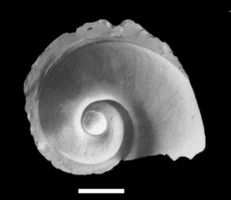
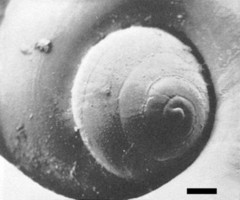
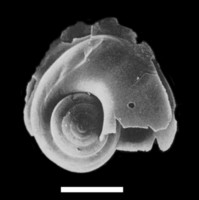
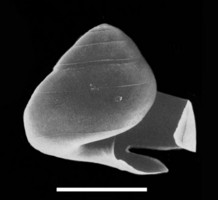
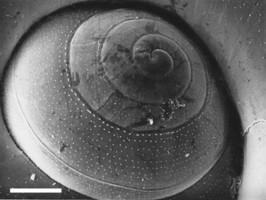
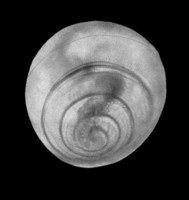
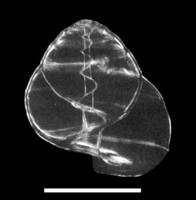

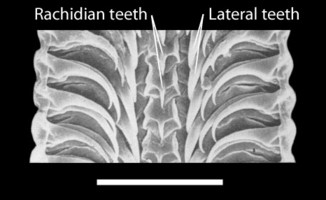
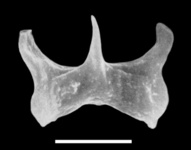


 Go to quick links
Go to quick search
Go to navigation for this section of the ToL site
Go to detailed links for the ToL site
Go to quick links
Go to quick search
Go to navigation for this section of the ToL site
Go to detailed links for the ToL site